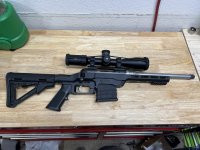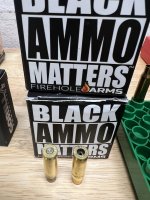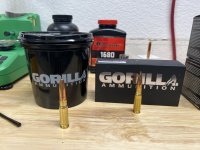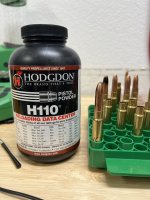New to this group and love all the information. Took me all day to get through 12 pages of great info. I am seeing lots of info on gas guns and just a little bit on bolt guns, especially shorter ones like my 12.5". I have built a list of load recipes based off all 12 pages in this thread and that has provided me with what I feel like is a good starting point for next steps. To date I have only shot Gorilla and then attempted to shoot Firehole Arms (I'll explain that later). The Gorilla performs great out of my rifle true MOA or better. Little bit about the gun and my experience
Project Gun: Savage model 10 youth 7-08 (my sons old rifle he grew out of). Mos-Tek 12.5" Savage Prefit Nut with 5/8x24 threading and an 11-degree crown. I have it sitting in an MDT LSS Chasis with an Arken EPL4 4-16 on it for now.
Experiences with different factory ammo:
Gorilla ammo has been great:
I started with the 300 SMK subs and I am getting 978fps with single digit SDs and very tight groups at 100
For hunting, I am using Gorilla 285 Fracturing subs. I am averaging 986fps and able to shoot just shy of 1 moa SDs were not as good as the SMK but for hunting out to 200 yards it does not matter.
Firehole Amrs:
I started with their 300 grain solid copper subs for barrels shorter than 16". 1st shot had significantly more recoil and was much louder than the 300 grain Gorilla. pulling the bolt back was tough and the primer popped a little and the base was flattened. I did not shoot those again that day
Next I shot the 338 grain fracturing and pretty much similar results only the primer completely fell out and unburnt powder was everywhere. did not shoot again that day
Took the rifle home and reverified the headspace with go no go gauges. Everything seemed fine but I went ahead and pulled the ejection pen/spring and extractor and checked head space again and still everything was in spec.
Back to the range with my Mangeto Speed v3. Both of the Firehole ammos were over 1150 fps and I had the exact same issue 1 flattened primer and one blown primer. I had to use a cleaning rod and block of wood to tap the spent fracturing round case out.
I ordered a Sheridan Case gauge and you can see from the picture that the Firehole ammo does not even come close to fitting.
Ok on to my questions:
1. I am loading Maker Rex 350 expanding in new Gorilla brass with federal LRP and h110. I am starting at 15.1 grains and going to 16.3. Does the collective think this is a good start for a bolt 12.5" gun?
2. I only have a little bit of H110 and A1680 but lots of CFE BLK. Does anyone have a good sub or super recipe to start with for CFE BLK




?














